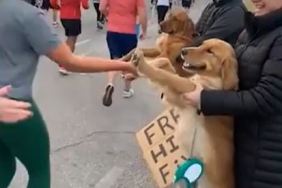The night before the 2015 Chicago Marathon, I posted the following to my personal Facebook page:
“I’ll just never understand why anyone would do that to themselves.” … “I don’t run unless someone is chasing me.” … I crack up over how often I hear such remarks when talking about my marathon training. And as I’m just hours away from trying to conquer Chicago, I feel the need to explain why I do what I do.
My dad had a heart attack at age 49 and is lucky to be alive. I always knew I had to take care of my body, but his life-changing event was certainly a wake-up call. Unfortunately, I need to set crazy goals for myself in order to stay in shape, and by running races, I’ve found it.
But it’s also much more than simply ‘goals.’
I do it to feel alive.
I do it to be part of something much bigger than myself.
I do it to accomplish something few people have.
And most importantly, I do it for the people who can’t.
When I run tomorrow I’ll be thinking of my childhood friend and high school basketball teammate Justin Kauffman, whose life ended way too young from a heart simply too big. I’ll be thinking of Brayden Eidenshink, who is the toughest and bravest kid I’ve ever met, who continues to battle heart disease day in and day out. I’ll be thinking of my best friend Bob Hayes and his sister, Suzie, whose life was taken way too soon from cancer. I’ll even be thinking of all the veterans who have served our country.
Why?
Because whether it’s Justin or Suzie, Brayden, or the countless veterans who can’t run, I know all of them would be living their lives to the fullest if they could. And because I can, I have no choice but to take advantage of this amazing life God has blessed me with.
Finishing a marathon is a tremendous metaphor that you can accomplish anything in life. To those who haven’t blocked me yet or have actually taken the time to read this monologue, I truly appreciate all your support from the bottom of my heart and I hope you can continue to follow me on my journey.
I’ll see you at the finish line.
I want to make it clear that I am not a runner. I’m just an average guy who played sports in high school and one, now in my low-metabolized adulthood, who makes myself run. There’s a difference. A big one.
Another reason for running a marathon is to help inspire those who think they can’t.
I never ran more than 5.5 miles in my life until I started training for the 2014 L.A. Marathon. Now that I know I can do it with the proper training, I’m hooked for life. Sure there are other ways to get a rush of endorphins, but do they get you a fancy medal?
How to train
First and foremost, I’m no expert. And just because I already completed one marathon before certainly didn’t make Chicago any easier.
Unless you’re a freak of nature who can run non-stop, year-round without being injured, perseverance and extreme determination are the only things that will carry you through the finish line. Well, that, and a cousin who’s done marathons before.

Thousands of runners crossing the starting line of the 2015 Bank of America Chicago Marathon on Columbus Drive. Photo: Getty
My cousin Jeff pointed me towards HalHigdon.com and told me he’s followed the former Runner’s World writer’s training modules for years with great success. He had done the Chicago Marathon multiple times using Hal Higdon. After using it myself, I highly suggest one of his training programs if you’re a first-timer, especially if training by yourself as I did.
But there are other things you need to know.
The #1 golden rule of training — Never, ever, miss your weekly ‘long run.’
#2 Always get fitted for real running shoes.
Everyone’s gait is different and you’ll be surprised how the right fit and padding will prevent injury. Remember, you’re running up to 30-40 miles a week at the peak of your training. I injured my foot one time simply because I was tying my shoes too tight. Not even kidding.
#3 Fuel properly
Don’t ever under-estimate what you put in your body, before and after a run. You need plenty of glucose and carbohydrates to burn during your run, followed by plenty of food to re-fuel your tank afterwards.
Here’s what’s worked for me.
Fuel for the long-haul
Before: The morning of my run I’m eating whole wheat toast with peanut butter, honey, cinnamon and banana. Also, a hit of Glukos — whether it be the bar, drinking powder or gummies, the stuff really works.
Two nights before my long run I’m pounding a bunch of pasta. You want to give your body plenty of time to ingest all the carbs you need for your long run. Drinking a ton of water days in advance is a must-as well.
During: You’ll need to bring some things with you during your long runs, especially when you get into the high miles. I like to pack the Glukos gummies along with the ‘extreme’ Jelly Bellie ‘Sport Beans.‘ They didn’t make my stomach feel heavy or upset.
After: Alongside a Jimmy John’s turkey sandwich, I like washing away my long runs with NuAquos to help replenish some electrolytes. Plus the stuff has protein for recovery.
But of course, everyone’s different and you have to find what works for you.
Race day

The health and fitness expo Friday and Saturday before the race is one of the most fun experiences you’ll have before the race. Mingle with thousands of other runners, buy some sweet gear and pick up your race bib and t-shirt. They make the signs large enough so you don’t wear yourself out getting lost!
After about seven months of training (more than 500 miles), Sunday, October 11 was finally the big day — race day.
So what’s it like to run in a marathon? It’s kind of like going to Disney World for the first time as a kid. Or, if you’re my dad, the night before deer hunting season …
It’s hard to sleep the night before the race. You’re excited and anxious. The morning of the race you just pray your stomach is somewhere between letting you have a good breakfast and allowing you to drop the kids off at the pool pre-race.
You start the day eager, hyper and excited only to finish totally physically and emotionally drained.
Maybe Disney World isn’t the best comparison, but just like a busy theme park, it’s just as important to get to the race early.
For the Chicago Marathon, it was especially important to get there before sunrise. We arrived around 6 AM even though my corral didn’t close until 7:45. You see, since there’s 50,000 runners (the 2nd largest marathon in the world), they actually herd you into corrals based on your estimated finish time.

Considering I still look human, this picture was taken at the health and fitness expo about 36 hours before the race.
The starting line
After the gun went off at 7:30, it took about 40 minutes just to reach the start line. Remember, there’s 50,000 people — about 25 times the size of my hometown.
The energy is incredible. There’s music. People are happy and excited. And in my case, the weather was nearly perfect — sunny and low 60s.
My family was tracking me with the official race app and through text updates so they were aware when I started the race. I also told them I would be on the right side of the street, which was HUGE for them in order to spot me. With an endless flow of people jogging shoulder to shoulder it’s possible they never would have seen me otherwise.
Chicago, just like LA, had people cheering us runners along the whole route.
Some neighborhoods had legitimate cheerleaders. Some had nuns. Some had bands. The hispanic neighborhoods had authentico musica blaring with dancers. Chinatown had Chinese music and dancing. There were kids. There were residents from nursing homes waving from their second story windows. There were loads of Cubs fans, possibly Wrigleyville being the most fun and rowdy area … It really was pandemonium. It was one, big party of nearly two million people cheering on 50,000 runners.
It’s truly an incredible experience to feel the energy of a city supporting you as you traverse through the urban maze of Chicago streets.

You’ll see people dress up in costume as they cheer you on. Blown up pictures are also the norm. Photo: Getty
The best signs I encountered include “Don’t trust a fart after mile 20” and “Keep going. Derrick Rose would have injured himself by now.” Of course there were also plenty of political signs, including, “If Donald Trump can run for president, you can run a marathon,” and “You’re running better than the government.”
The race is a total blast, but you also find that the party doesn’t last forever.
The wall
If you’ve ever had a conversation with someone who’s ran a marathon, you’ve heard of ‘the wall.’ It’s real. And in most cases, there’s nothing you can do about it. You just have to mentally prepare and hope that your training will carry you through.
I hit the wall hard around mile 19-20 in the Los Angeles Marathon last year. I was in a lot of pain, but pushed through to finish in a time of 4:35.
In Chicago, I hit the wall hard around miles 20-21, only this time it wasn’t exactly pain. It was cramps. In my opinion, worse.
For my Chicago training I saw a chiropractor regularly for not only adjustments, but for massage and, most importantly, my custom made orthotics.
I sound like an old man, but without those orthotics I can’t jog a mile without a disc in my back blowing up like a golf ball.
So here I am, with just 5-6 miles to go, and the infamous wall hits. My entire right quad starts cramping up. Stopping to stretch and attempting to walk it off only helped minimally. It was very disheartening. You can’t run when you’re cramping, just ask LeBron.
Does everyone hit the wall? I have no idea. But if you watch a marathon it’s easy to tell most do. Everyone’s pace diminishes exponentially after mile 20 and the closer to the finish line you get the more people you see walking.

Still within the first 3 miles of the marathon, these people are actually running and are therefore an example of the exact opposite of ‘the wall.’
The finish line
Although I was on pace for a 4:20ish finish, the cramps continued to worsen and my pace slowed accordingly.
I saw my family for the fourth and final time along with route with just about 800 meters to go. I had nothing left, but mustered up a slow jog while going past them, giving them a thumbs up in the process. They were amazing cheerleaders. Much better than I could have ever imagined.
With less than 400 meters to go and the finish line just around the corner, my entire left arm cramped up. Yup, that can happen, evidently.
I had to let my arm dangle. The cramping subsided only if I kept it straight.
So just imagine a 6-foot-2 skinny white dude who’s completely dehydrated, limping on one leg, arm dangling — Yup, I’m certain I looked like a zombie.
Before running L.A. my large and in charge trainer friend of mine explained to me that he had run the marathon twice before and that every time he finishes he goes to his car and cries like a little girl for at least five minutes.
Unless you’re used to finishing these insane races, the emotion that overcomes you when crossing the finish line is indescribable.
You don’t even understand why you’re crying. Sure, you may be in pain and you’re tired and your body is wondering ‘what the hell did you just do to me?!’ But I also think its partly because you’ve spent months training for this one moment. You have thousands of people cheering you on. And most runners are running for a cause, a person — something much larger than themselves.
Once I finally crossed the finish line I wanted to cry. My mouth frowned and face trembled just as one does moments before unleashing water falls. But nothing came out. I was too dehydrated.
I had just completed 26.2 miles, the final 6 being pure hell. I felt like hell. Yet I was overcome with ecstatic joy, joy one can only feel finishing a marathon. It really is one of the strangest yet most fulfilling moments you’ll ever experience.
Post race
I had to walk nearly a half mile to gear check to reclaim my things (wallet, phone, etc.) and then I was lucky enough to find a patch of grass near a tent in Grant Park where I could collapse for awhile until my body recovered, also giving my family ample time to find me.
Unfortunately I wasn’t one of the many who felt able enough to partake in the free post-race Goose Island beer just after the finish line.

My family and I more than two hours after crossing the finish line and after I was able to stand on my own again.
I laughed and spoke real horsely with my family for about two hours before I felt human again. We then went to a buffet in the suburbs where I happily destroyed some Asian food before checking into the hotel where I literally laid in bed and slept from 6:30 PM until 7:30 AM.
My feet hurt. My legs hurt. My head hurt.
Would I do it again?
The short answer is hell yes. It’s an answer even I can’t believe.
I, who hit ‘the wall’ after mile 20, kept telling myself “Never again, you idiot. Why did you do this?!,” will run another marathon? I only did my first because I was freaking out about turning 30.
It will be a couple of years until it happens again, but there will be another. And I’ll do it for the same reasons listed at the beginning of this article.
I do it to feel alive.
I do it to be part of something much bigger than myself.
I do it to accomplish something few people have.
And most importantly, I do it for the people who can’t.
Josh Helmuth is the editor of CraveOnline Sports.








